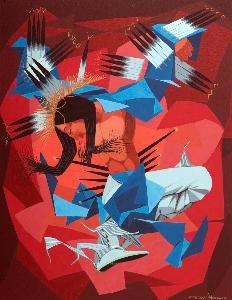Howe, Oscar (Yanktonai Sioux)
Howe, Oscar (Yanktonai Sioux);Oscar Howe (Yanktonai Sioux)
Place: Crow Creek Indian Reservation
Born: 1915
Death: 1983
Biography:
Oscar Howe was a Yanktonai Sioux painter who is considered one of the most innovative Native American artists of the twentieth century. Born on May 13, 1915, on the Crow Creek Indian Reservation in South Dakota, Howe learned traditional Sioux symbols from his maternal grandmother Shell Face. After contracting tuberculosis, he attended the Santa Fe Indian School where he studied under Dorothy Dunn.
Artistic Style and Influences
Howe's artwork is known for its innovative use of abstract explorations of planar space, Sioux symbolic geometries, and experiments in Cubism. His style is marked by bright colors, dynamic motion, and primitive forms. Oscar Howe is credited with influencing contemporary Native American art, paving the way for future artists. Key influences on Howe's work include his traditional Sioux heritage and his exposure to modern art movements such as Cubism and Abstract Expressionism. He was also influenced by his time at the Santa Fe Indian School, where he learned from prominent artists of the time.
Notable Works and Exhibitions
Some of Howe's notable works include Belt Pouches and Black Hills with Cedar. His artwork can be found in various museums, including the Eiteljorg Museum of American Indians and Western Art, which is home to one of the largest collections of Native American art in the world.
- Painting by 'Howe, Oscar (Yanktonai Sioux)': This casein painting is a testament to the artist's skill and creativity.
- Geometric Abstract Art: A form of abstract art based on the use of geometric forms, which was popularized by avant-garde artists in the early twentieth century.
- Howe, Oscar (Yanktonai Sioux): A Yanktonai Sioux painter who is considered one of the most innovative Native American artists of the twentieth century.
Legacy and Impact
Oscar Howe's legacy extends beyond his own artwork. He paved the way for future generations of Native American artists, influencing contemporary art movements and inspiring new artists to explore their cultural heritage. His work can be found in museums such as the Eiteljorg Museum of American Indians and Western Art and the Smithsonian American Art Museum. Today, Howe's artwork continues to be celebrated and exhibited around the world. His innovative style and use of traditional Sioux symbols have made him a pioneer in Native American art. For more information on Oscar Howe and his artwork, visit Wikioo.org.




